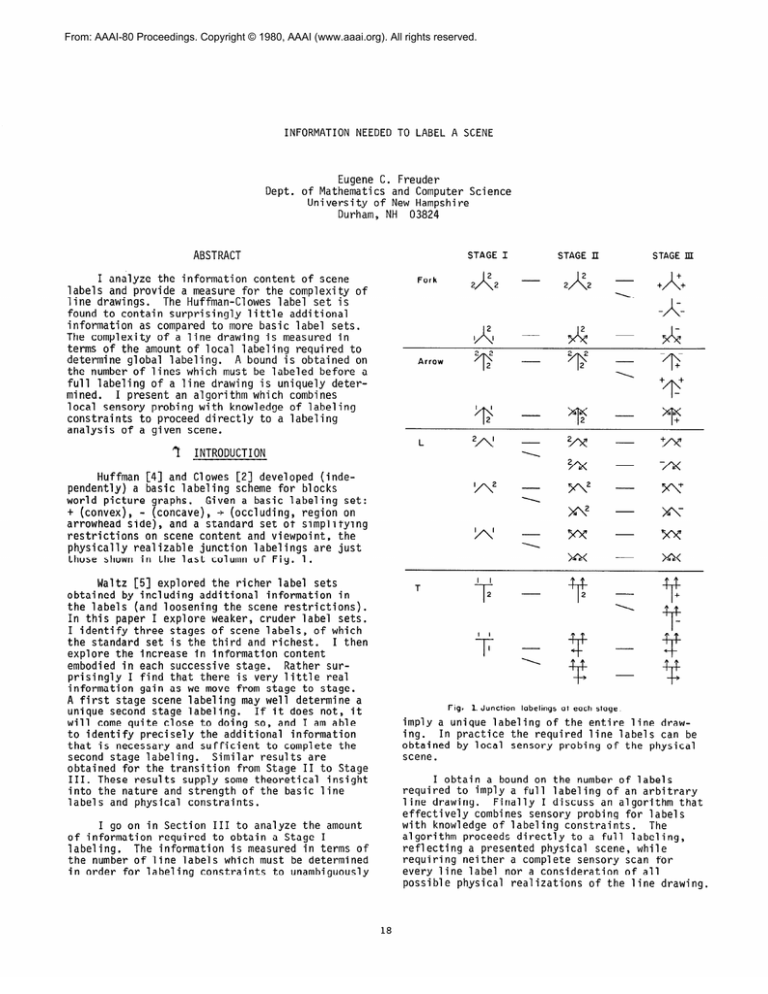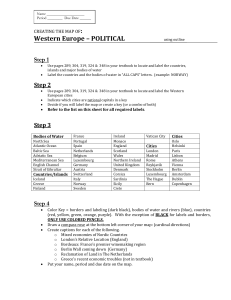
From: AAAI-80 Proceedings. Copyright © 1980, AAAI (www.aaai.org). All rights reserved.
INFORMATION
Dept.
NEEDED
TO LABEL
A SCENE
Eugene C. Freuder
of Mathematics
and Computer Science
University of New Hampshire
Durham, NH 03824
ABSTRACT
STAGE
I analyze the information content of scene
labels and provide a measure for the complexity of
line drawings.
The Huffman-Clowes
label set is
found to contain surprisingly
little additional
information as compared to more basic label sets.
The complexity of a line drawing is measured in
terms of the amount of local labeling required to
determine global labeling.
A bound is obtained on
the number of lines which must be labeled before a
full labeling of a line drawing is uniquely determined.
I present an algorithm which combines
local sensory probing with knowledge of labeling
constraints to proceed directly to a labeling
analysis of a given scene.
"r
Fork
A
I
2
2
STAGE
A
-
2
2
II
STAGE
2
-
2
A
III
+
+
+
Arrow
INTRODUCTION
Huffman [4] and Clowes [2] developed (independently) a basic labeling scheme for blocks
world picture graphs.
Given a basic labeling set:
+ (convex), - (concave), -+ (occluding, region on
arrowhead side), and a standard set of simplifying
restrictions on scene content and viewpoint, the
physically realizable junction labelings are just
those shown in the last column of Fig. 1.
Waltz [5] explored the richer label sets
obtained by including additional information in
the labels (and loosening the scene restrictions).
In this paper I explore weaker, cruder label sets.
I identify three stages of scene labels, of which
I then
the standard set is the third and richest.
explore the increase in information content
embodied in each successive stage.
Rather surprisingly I find that there is very little real
information gain as we move from stage to stage.
A first stage scene labeling may well determine a
unique second stage labeling.
If it does not, it
will come quite close to doing so, and I am able
to identify precisely the additional information
that is necessary and sufficient to complete the
second stage labeling.
Similar results are
obtained for the transition from Stage II to Stage
III.
These results supply some theoretical
insight
into the nature and strength of the basic line
labels and physical constraints.
I I
T
T
2
Fig.
1. Junction
-
labelings
-
2
+I+
ot
each
T
+i
stage
imply a unique labeling of the entire line drawIn practice the required line labels can be
ing.
obtained by local sensory probing of the physical
scene.
I obtain a bound on the number of labels
required to imply a full labeling of an arbitrary
line drawing.
Finally I discuss an algorithm that
effectively combines sensory probing for labels
with knowledge of labeling constraints.
The
algorithm proceeds directly to a full labeling,
reflecting a presented physical scene, while
requiring neither a complete sensory scan for
every line label nor a consideration
of all
possible physical realizations
of the line drawing.
I go on in Section III to analyze the amount
of information required to obtain a Stage I
The information is measured in terms of
labeling.
the number of line labels which must be determined
in order for labeling constraints
to unambiguously
18
II
LABELING
tions that have a 2 label on one line, i.e. pulling
the two sides of each such L apart to remove the
junction.
The Stage I labeling uniquely determines a Stage II labeling on all connected components of the resulting graph except those consisting solely of l-labeled lines, none of which is a
crossbar of a T. A unique labelinq for the exceptions may be determined by specifying the Stage
II label of a single line in each such component.
STAGES
The standard label set is a refinement of a
cruder categorization
of lines as representing
a
physical edge of either one or two visible faces.
I consider three labeling stages.
In Stage I the
only labels are the numbers 1 and 2, indicating
the number of associated faces.
In Stage II, the
number 1 is replaced by occlusion labels (+)
indicating which side the single face is on.
They
will be termed Stage II labels.
A Stage II labeling will be one that utilizes -f and 2 labels.
In
Stage III the number 2 is replaced by + and as the distinction
is made between convex and
concave edges.
The labels + and - will be termed
Stage III labels. - A Stage III labeling is one
that utilizes +, - and -f labels.
For proofs
c31
C.
Graph
I to Stage
Theorem 1.
Stage I labeling
Further separate
--II
to Stage
III
OBTAINING A STAGE
I LABELING
The limitations on physically realizable
labelings summarized in Fig. 1 easily give rise to
a set of "implication rules" for completing a
junction labeling given the labelings of one or
two of its lines.
These rules are listed in Fig.
2.
Note first that labels for shafts of arrows
and crossbars of T's can be derived immediately
(2's and l's respectively),
without any previous
labels.
Labels for two of the lines of a fork or
arrow imply the third.
(Thus, in effect, a single
line label, other than for the shaft, determines
an arrow labeling.)
I
=>I\ 2
p
The connected components of a graph are the
maximal connected subgraphs, where a graph is
connected if there is a chain of edges between any
two vertices.
Stage
see
Given labels for a sufficient number of lines
the physical constraints on the labeling process
will imply a unique labeling for the remainder of
the scene.
A bound on this "sufficient number"
will provide a bound on the complexity and potential ambiguity of the picture graph, and on the
effort required to label it.
A blocks world line drawing is, of course, a
graph.
For the purposes of our analysis we will
modify picture graphs by "separating" T junctions,
removing T junctions by pulling the shafts away
from the crossbars.
After labeling a scene
separated in this fashion the T junction labelings
are easily recovered by rejoining the T junctions
to form the original scene.
The separation
reflects the fact the information does not pass
through a T junction , and will permit us to
identify independent segments of the scene as
connected components of the (separated) picture
The segments are independent in the sense
graph.
that each can be labeled independently,
a label in
one segment can have no bearing on possible
labelings for the other segment.
B.
Stage
III
My interest in Stage ,J labeling was aroused
by the work of Chakravarty
[1] who utilized information about the number of regions associated with
lines and junctions, in connection with a more
elaborate labeling scheme.
The Picture
--
in this paper
Theorem 2. Given a picture graph with a
Stage II labeling (separated at T junctions).
The
Stage II labeling uniquely determines a Stage III
labeling on all connected components except those
consisting solely of 2-labeled lines.
A unique
labeling for the exceptions may be determined by
specifying the Stage III label of a single line in
each component,
At Stage I there are only 9 distinct junction
At Stage II the L labelings are differlabels.
entiated, at Stage III the fork and arrow labels
are differentiated.
Fig. 1 shows the physically
realizable labelings at each stage.
T labelings
are added at each stage, but notice that fork and
arrow labelings do not increase in moving from
and the number of L labelings
Stage I to Stage II,
does not increase in moving from Stage II to Stage
III.
Thus we really do not know any more about
forks and arrows at Stage II than we do at Stage
I, nor more about L's at Stage III than at Stage
II.
Once we have labelled a fork 2,1,1 for
example, we really know already that it can be
labelled 2,+,-t.
A.
of the theorems
l
=>yp
=>
I
T
yp =>‘;1‘
II
Given a picture graph with a
(separated at T junctions).
the graph by separating L junc-
Fig. 3. Implication
19
rules.
I will say that the labelina of a subset of
picture graph iines implies the labeling of the
entire graph, if repeated application of the
implication rules of Fig. 2;'starting with the
given subset, leads to a complete, unique labeling
of t,he graph.
The labeling of a subset of lines
is sufficient if the labeling implies the labeling
of the graph.
A subset of lines is sufficient if
any consistent lamoftheubset
is sufficient.
The minimal number of lines in a sufficient subset will be called the sufficient number
of the picture graph.
The sufficient number must,
-of course, be determined relative to a specified
label set.
We will be dealing with sufficiency
for Stage I labeling in this paper.
Note that deduction can "propagate":
we may
deduce a label for a line which in turn permits
deduction of the label for an adjoining line, etc.
There is room for heuristic tuning in choosing
which lines to probe for labels.
Fig. 3 demonstrates
thi s labeling algorithm
on a simple scene.
The fort uitous choice of a 2labeled L line to probe for labeling permits us to
(Actually
get away with a single senso ry probe.
It is
the choice need not be entir ely fortuitous.
reasonable to suspect that t he "bottom lines" will
be 2-labeled.)
+
+
m
In Section
A I obtain an upper bound on the
In [3] I
sufficient number of a picture graph.
discuss means of obtaining sufficient sets of
lines (and thus, bounds on sufficient numbers) for
individual graphs; I modify one of these methods
to provide a test for the sufficiency of a set of
lines or line labels, and a labeling algorithm.
This algorithm is discussed in Section B.
A.
A Bound
---Graph
on the Sufficient
Number
I
a.
of a Picture
@
The bound provided by the theorem is tight,
in the sense that I can exhibit a picture graph
with sufficient number equal to the given bound.
A simple triangular figure may consist of all
occluding lines, or one of the lines may have a 2
label.
Knowing the labeling of two lines is not
sufficient to imply the label of the third for all
possible labelings.
Thus, the sufficient number
is three, which equals the number of forks and
arrows (0) plus the number of connected components
in the graph separated at T's and L's (3).
(In
general the sufficient number of a picture graph
will be considerably
less than the bound provided
by the theorem).
A Labeling
[1]
Algorithm
unlabeled
3. Labeling
l@l
O=>probed
algorithm.
REFERENCES
A generalized line and
Chakravarty,
I.
junction labeling scheme with applications
(1979)
scene analysis, IEEE Trans. PAMI202-205.
PI
On seeing things,
Clowes, M.B.
Intelligence 2 (1971) 79-116.
c31
Freuder, E. On the Knowledge Required to
Label a Picture Graph.
Artificial
IntelliQence, in press.
lines
to
Artificial
Impossible
objects
as nonsense
D.A.
sentences, in: Meltzer, B. and Michie, D.
(Eds.), Machine Intelligence 5 (Edinburgh
Univ. Prminburgh,
1971) 295-324.
II41 Huffman,
Obtain any labels that can be deduced by
1.
repeated
application
of the implication rules of
Figure 2.
(No t e arrow shafts and T crossbars
can be labeled immediately.)
While
=>
Fig.
Algorithm:
2.
I
w.2
Theorem 3. The sufficient---- number of a picture
graph is no more than the number of forks and
arrows plus the number of connected components of
the graph separated at T's and L's.
B.
I+
D. Understand ing line drawings of
scenes wit h shadows, in: Winston, P.H.
(Ed.), The Psychology of Computer Vision
(McGraw-Hill,
New York, 1975
19-91.
II51 Waltz,
remain:
2.1. Pick an unlabeled line and "probe"
the physical scene to determine its label.
(This
information could be obtained from visual, tactile,
or range finding data.)
2.2. Deduce any further labels that can
be obtained by repeated applications
of the
implication rules.
20


